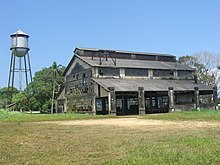Fordlândia
Fordlândia (1920–1945), also Fordlandia (named after Henry Ford ), is a place south of Santarém in Amazonia . The US car maker Henry Ford wanted to manufacture inexpensive car tires in the 1920s . Due to mismanagement and technical advancement in rubber tire manufacture , the project was a misinvestment of 25 million US dollars . Today, with around 1200 residents (2010: 1176), it forms the 14,568 km² Distrito de Fordlândia of the city of Aveiro in the state of Pará . Although Fordlândia is often referred to as a ghost town, the place has over 1000 inhabitants even today.
history
In the 1920s, the Ford Motor Company acquired a 10,000 km² piece of virgin forest on the Rio Tapajós in Amazonia to build a rubber plantation . At that time, the raw material for car tires was only obtained naturally and Ford wanted to be as independent as possible of the production from the then British Malaysia in the sense of a vertical backward integration of its company . In 1928, a small American town for 8,000 local workers was built with a power station, swimming pool, cinema, fire department and hospital. The products were to be shipped all over the world via the Tapajós and Amazon rivers, including São Paulo , where a Ford factory was located.
Mismanagement
The landscape is hilly and barren, and none of Ford's managers had the necessary knowledge of tropical agriculture. The rubber plantation was never a success, not only because the rubber trees were too close together instead of, as is customary in Brazil , being grown at a great distance from one another. Above all, the local workers could not get used to the working conditions. You should live like you would in a small US town; B. Carry ID cards, adhere to North American working hours (from 6 a.m. to 3 p.m.) and get used to the American way of life, including American food such as hamburgers and a smoking and alcohol ban . In December 1930 there was an uprising against the prescribed rules of life and nutrition. This was put down by the Brazilian military. The government became increasingly suspicious of foreign investors and did not continue to support the project. Ford made one more try further downstream on flatter terrain at Belterra . Rubber production never really started up for a variety of reasons, and apart from a few samples, no significant quantities were sent to Ford in the United States . A main reason for the failure was the infestation of the rubber trees with the South American leaf fall disease (also South American powdery mildew ), which is caused by the fungus Microcyclus ulei, which does not occur in Asian rubber- growing areas .
The end
Synthetic rubber was developed by 1945 and Ford immediately stopped all payments. His grandson Henry Ford II sold the city to Brazil for $ 250,000 after investing over $ 25 million. The facilities continued to be serviced for a while, but soon the 800 residents couldn't stop the decline.
In 1944 Walt Disney made a commercial for the project called " The Amazon awakens ".
literature
- Mary A. Dempsey: Fordlandia . In: Michigan History. Volume 78, No. 4, 1994, pp. 24-33 (with photos, digitized version ( memento of January 7, 2008 in the Internet Archive )).
- Frank Thadeusz: End times in the jungle. In: Der Spiegel. 6/2010, p. 145 f.
- A ghost town remained from the American king's dream of the jungle: Fordlandia. In: Der Spiegel. 38/1992, September 14, 1992 ( digitized version ).
- Eduardo Sguiglia: Fordlandia. Europa-Verlag, Hamburg 2002, ISBN 3-203-82006-4 .
- Greg Grandin: Fordlandia - The Rise and Fall of Henry Ford's Forgotten Jungle City . Faber and Faber Ltd., New York 2010, ISBN 978-1-84831-147-3 .
Web links
- Ursula Prutsch , Peter Stamm : Fordlandia - on the way where? (Documentary, 40 minutes) July 17, 2014 .
- Christoph Gunkel: Forgotten Places: Henry Ford's Lost Jungle City. In: one day on Spiegel Online . February 11, 2010 .
- Amy Goodman , Juan Gonzalez: Fordlandia: The Rise and Fall of Henry Ford's Forgotten Jungle City. ( mp4 video , 120 MB, 46 minutes and transcript) In: democracynow.org. July 2, 2009 (English, interview with Greg Grandin).
- Tom Noga : Fordlândia ghost town - Henry Ford's unsuccessful Amazon adventure. ( mp3 audio , 28.1 MB, 30:45 minutes) In: Deutschlandfunk-Kultur , broadcast “Die Reportage”. 2nd June 2019 .
- Defeated by the jungle
Individual evidence
- ↑ Sinopse por setores - Censo IBGE 2010 . IBGE , accessed May 12, 2018 (Brazilian Portuguese).
- ↑ What remains of the megalomania. In: Frankfurter Rundschau , June 10, 2013, pp. 16-17.
-
↑ Microcyclus ulei (South American leaf blight of rubber). In: cabi.org. CABI, Invasive Species Compendium, accessed May 12, 2018 . Christoph Gunkel: Forgotten Places: Henry Ford's Lost Jungle City. In: one day on Spiegel Online . February 11, 2010, accessed May 12, 2018 .
Coordinates: 3 ° 49'53 " S , 55 ° 29'51" W.

